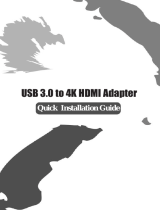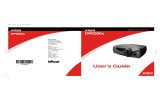1
Declaration of Conformity
Manufacturer: InFocus Corporation, 27500 SW Parkway Ave. Wilsonville,
Oregon 97070 USA
European Office: Louis Armstrongweg 110, 1311 RL Almere, The
Netherlands
We declare under our sole responsibility that this projector conform to the
f
ollowing directives and norms:
EMC Directive 2004/108/EC
R&TTE Directive: 1999/5/EC
EuP Directive: 2005/32/EC
Low Voltage Directive: 2006/95/EC
ETSI: EN 300 440, EN 301 489
EMC: EN 55022, EN 55024, EN 61000-3-2, EN 61000-3-3
Safety: IEC 60950-1:2005, MOD.
Trademarks
DisplayLink is a trademark of DisplayLink Corporation.
Apple, Macintosh, and PowerBook are trademarks or registered trademarks
of Apple Computer, Inc. IBM is a trademark or registered trademark of
International Business Machines, Inc. Microsoft, PowerPoint, and Windows
are trademarks or registered trademarks of Microsoft Corporation. Adobe
and Acrobat are trademarks or registered trademarks of Adobe Systems
Incorporated. DLP® and the DLP logo are registered trademarks of Texas
Instruments and BrilliantColor™ is a trademark of Texas Instruments.
InFocus, In Focus, and INFOCUS (stylized) are either registered trademarks
or trademarks of InFocus Corporation in the United States and other
countries.
NOTE: This product is covered electrical and electronic
equipment under the European Union'
s Waste from Electrical
and Electronic Equipment ("WEEE") Directive (2002/96/EC).
The WEEE Directive requires that covered equipment be
collected and managed separately from typical household waste
in all EU member states. Please follow the guidance of your local
environmental authority or ask the shop where you purchased
the product for collection or recycling options.
FCC Warning
This device complies with part 15 of the FCC Rules. Operation is subject to
the following two conditions: (1) This device may not cause harmful
interference, and (2) this device must accept any interference received,
including interference that may cause undesired operation.
Note: This equipment has been tested and found to comply with the limits
for
a Class B digital device, pursuant to part 15 of the FCC Rules. These
limits are designed to provide reasonable protection against harmful
interference in a residential installation. This equipment generates, uses and
can radiate radio frequency energy and, if not installed and used in
accordance with the instructions, may cause harmful interference to radio
communications. However, there is no guarantee that interference will not
occur in a particular installation. If this equipment does cause harmful
interference to radio or television reception, which can be determined by
turning the equipment off and on, the user is encouraged to try to correct
the interference by one or more of the following measures:
--Reorient or relocate the receiving antenna.
--Increase the separation between the equipment and receiver.
--Connect the equipment into an outlet on a circuit different from that to
w
hich the receiver is connected.
--Consult the dealer or an experienced radio/TV technician for help.
Changes or modifications not expressly approved by InFocus Corporation may void
authority to operate the equipment.
Canada
This Class B digital apparatus complies with Canadian ICES-003.
Cet appareil numérique de la classe B est conforme à la norme NMB-003 du
Can
ada.
Agency Approvals
UL, cUL
Other specific Country Approvals may apply. Please see product
c
ertification label.
This document applies to regulatory models W3902 and W3904.
Input ratings: 100-240Vac, 3.3-1.2A, 50-60Hz
InFocus reserves the right to alter product offerings and specifications at
a
ny time without notice.





















